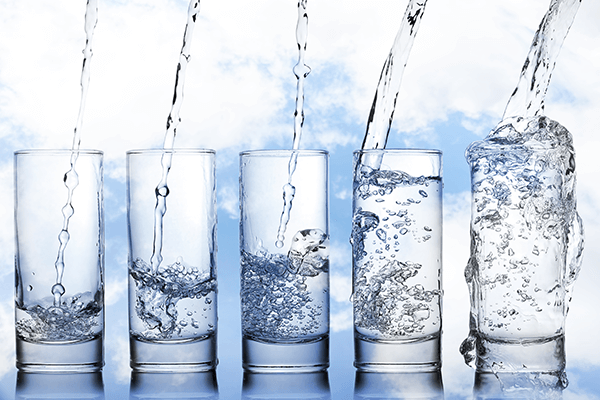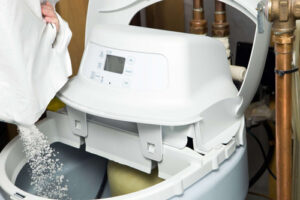
Most people are fairly confident that their drinking water is perfectly safe. There’s something about the fact that it comes out of a faucet that gives legitimacy to a perception of safety, whether you are drinking private well water or “city” water. But almost no one knows what is really in their water or what it is being treated for (if anything). I always ask people: If I could put a piece of spaghetti in the water at the beginning of the treatment plant or in the well and it went through all the pipes and eventually came out of your kitchen faucet into your hand, would you eat it? No one has ever said yes! And yet some are willing (at first anyway) to drink the water the spaghetti was delivered in.

Private well water is simpler—if you aren’t treating it, it isn’t being treated. Period.
How are contaminants in your water regulated?
The Environmental Protection Agency (EPA) issues what are called Maximum Contaminant Level (MCL) benchmarks for a variety of contaminants. An amount of a contaminant exceeding an MCL may be determined to be a health risk. The EPA also issues MCLGs. That is the goal level EPA would like to see achieved. Obviously, it is better to be at the MCLG than anywhere near the MCL. The EPA sets MCLs in five year cycles (every five years they set new MCLs). In 2010, EPA has 116 NEW contaminants it is studying for health effects (it started in 2008 with several thousand). In 2013 it will pick FIVE of those and set MCLs and MCLGs. The other 111 and the other thousands whittled from the list won’t have benchmarks set for them—not because they are safe (either alone or in a mixture) but because they are just not as dangerous as the Top Five. Then the cycle starts again
So, what really is in your water?
The U.S. Geological Survey recently announced the findings of a fourteen year study of well water. Here are some of the USGS findings:
- Of the 337 contaminants found in the water samples, EPA health benchmarks exist for only 193. Thus, the EPA has not determined what impact just under half the contaminants might have on you.
- 80% of the wells had contaminant levels greater than or approaching the EPA’s MCL.
- Many organic contaminants appeared in both source (raw) and finished (treated) water at the same levels. In other words, treatment had no effect.
- Pesticides and volatile organic compounds appeared at greater than EPA MCLs in 5% of the samples, mostly in heavily populated east coast areas—where we live.
- 55% of the samples had mixtures of at least 3 contaminants. There are no MCL health benchmarks for contaminant mixtures.
- 40% of the contaminant levels that exceeded health benchmarks are for unregulated contaminants—water utilities are not even required to treat for these.
Of course, we have all seen the articles about pharmaceuticals in your water. In Northwest Washington, DC recently the water supply was over-chlorinated and rendered undrinkable for part of a day (http://voices.washingtonpost.com/local-breaking-news/r-advisory-in-some-areas-o.html?referrer=emaillink). I even read an article recently about a treatment plant near Chicago that that was secretly using a well to supplement its “city” water that contained dry cleaning fluid (which of course the plant is not designed to remove) http://www.watertechonline.com/news.asp?N_ID=72582). At least with your private well you only have to worry about whatever has seeped into your local aquifer (the same one used for “city” water) or down your well pipe. Even so, some of Maryland’s private wells suffer from arsenic, nitrates and radium contamination. The EPA states that over 20% of private wells cannot pass a bacteria test and recommends at least annual testing (http://www.epa.gov).
Private organizations are taking up the cause of investigating water supplies. In May of 2009, the American Association of Pediatrics recommended that private wells be tested annually for contaminants such as nitrates and coliform bacteria, more frequently if there is an infant in the home (http://pediatrics.aappublications.org/cgi/search?sortspec=relevance&fulltext=well+testing). An August 2009 study identified higher rates of Parkinson’s disease among people drinking from wells contaminated with certain pesticides, some of which are also found in Maryland (http://www.environmentalhealthnews.org/ehs/news/parkinsons-and-pesticides). Importantly, in the past 60 days the President’s Cancer Panel has recommended water filtration as a barrier to cancer causing agents in drinking water in its 2008-2009 Annual Report, Reducing Environmental Cancer Risk (http://deainfo.nci.nih.gov/advisory/pcp/pcp08-09rpt/PCP_Report_08-09_508.pdf).
The technology exists to remove impurities from your water, regardless of their source. But it is up to the individual consumer to install and use these technologies. Applications like ultraviolet, ozone, nanofilitration and reverse osmosis are readily available for treatment of the water in your homes.
So I’ll ask you again: Are you really still drinking your tap water? We have the technology to make it better! Call us today for a FREE water analysis. We can help you to resolve all doubt regarding the quality of the water that you and your family are drinking.



